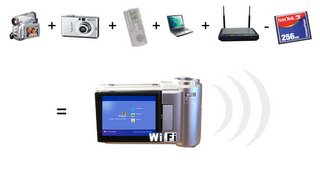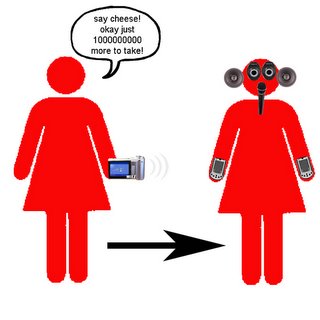final project: ourworld.com
Verb: To socialize: Virtually
Nowadays, it seems people are pushing towards the realm of virtual existence. People spend almost the majority of time in front of a computer screen to obtain news, entertainment, education and socialization. Socializing has turned into a form of instant message conversations, email correspondence and meeting new people have also started to grow in the form of virtual social spaces, such as friendster, craigslist and myspace. It seems people are no longer searching for physical conversations. It almost seems to be a rarity that people still meet for dinner!
We almost exist in two parallel worlds, the physical and the virtual. The physical world is still open to observation and interpretation. People can create evaluations based on physical gestures, mannerisms, other things unspoken and slight. The virtual world seems to be a projection of ourselves. We decide what the viewer can analyze and observe. It becomes more one-sided and bias. So if the physical is who we are, it is almost as if the virtual is who we would like to be.
The Virtual world creates a physical shell and continues to separate the two different worlds we exist in. Now, it seems easier to exist one sidedly. It allows us to guard ourselves, collage different foundations, other representations. It has bred an unavoidable and now growing passiveness and is slowly isolating physical publics. But now, these physical encounters even if brief are so much more meaningful and create larger impacts in comparison. Then as architects and designers, how can we use the tools and thinking process we have learned to better shape the virtual world? What can we do to create a more three dimensional virtual space that includes unintentional observations and interactions, such as random sidewalk encounters while walking to the subway station that exists in the physical world?
My proposal for a more three dimensional social sphere in the virtual world would try to recreate or re-enact the daily, physical routine that exists in our physical everyday.
+ + + +
www.ourworld.com
I have categorized the virtual internet sites I visit into three realms, the private, semi-public and the public and have paralleled them with physical substitutes. The most private realm in the virtual world is email. Email is a secure way of communication with a specifically intended viewer and the message is carefully created. I see this paralleling my most private space, my apartment. My apartment is a place where I have complete control of who comes in and out and basically the activities that carry out in that space. I have two main email accounts, my hotmail account and my gsd account. The physical spatial parallels would then be my apartment in
The semi-public space, I would categorize would be blog spaces. The audience is still random, to a certain extent, usually found through similar interest searches, blog rings or you referring friends to that site. Your identity is still anonymous to a certain extent, but you being to share ideas via posts. I see the physical equivalent to be a coffee shop or a specific interest retail store. These spaces are all semi-controlled, semi-public. They are only available to those who wish to patronize the commercial activity based on similar taste or interests. I have three blogs. A blog on my gsd website (created in digital media two years ago with Jef and Allen!!) which I can equate to the semi public spaces of Gund Hall, such as the Pit or Chauhaus. I have a xanga.com blog which is a bit more anonymous than the GSD blog, but I can see as my local coffee shop. The last blog is the class blog; this is an extension of our classroom.
The public sphere would be friendster, myspace and craigslist. These are basically unregulated sites, where people can browse without much problem (though there are privacy setting you can place on your website to restrict views, but that is a special case.) Random profiles are highlighted on your home page. This can be equated with a Central Park or
So my proposal for a more three dimensional virtual world, would be a way to connect and organize all these worlds in a similar way to our everyday physical activities. Ourworld.com would allow the user to give place based values to their internet sites, on a virtual map. You would be able to choose the platform of your virtual city; it could be based on the actual location, or a fantasy location. You would plug in the locations of all your site routines, basically “plan” the city according to your needs.
This website would allow other users to organize their routines and virtual existence on the same place. So when you go from email to your friendster page, you would have to “walk” through this virtual city. There would be a platform where you could also see who is walking along with you, to provide this potential unintentional interaction, you could choose to chat with this person as you would in the physical.
Let me demonstrate this visually to get a better understanding. Figure 1 shows the setup of this site. You get to choose, based on three main maps: your actual city location or another actual city you wish to “live” in, a beach getaway (non-specific to a real city), a rural setting. These three locations can correspond to three different lifestyles. It’s your virtual world, so you can choose your fantasy location. This is indicative of lifestyle so the odds of having people “live” in your community will have similar lifestyle choices, much like real life.
Once choosing your location, you assign place values for your internet site visits. I have decided to choose my actual city as my virtual map. I have placed all my internet sites on the virtual location map. As you can see, a lot of my “recreation” time is spent at the gsd. I have placed my hotmail account, my main mode of private communication at my apartment and my main public sphere in
So once the setup is complete, I can just use the map as my site guide and all my favorite websites are contained on one website. I can then click on the color nodes and surf the web as I would normally. The size of the node can start to correspond to frequency of usage as well.
When I go from site to site, this is where the platform changes. Rather than just flash from one page to another, you would walk the streets. Decide on a path to take, the stroll along the streets, from point A to B. You would be able to see what other users are in that vicinity and what path they are taking, to a certain extent. You would only be allowed to view who is within very close proximity, sight of view, not the omniscient-all-telling plan view, to see how crowded streets are. People can use avatars to represent themselves, ranging from an actual photo, to a cartoon icon to just a colored dot, depending on their personal preference, since the virtual world allows you to control amount of information revealed. You can see who else is walking along the street, at the same time. When rolling over their avatar, you would be able to see only basic information, name, location, where they are going. If you would like, you could pause on the street and start a conversation with these people, or ask them for “directions” to a new coffee shop, etc. Eventually, as the city grows, people can start assigning the same value to certain locations. For example, many people can start to assign their various blogs to the 1369 Coffeehouse on
In general, the way this website can grow is much like a real city, it’s up to the population to choose which areas are “hot spots” to hang out and the most used, main roads would be where the most unintentional interactions would occur.
This can be seen a slight improvement to the isolating factor of the virtual world. The problem with virtual space is that it is non place based and temporary. This website attempts to remedy both those problems. Although I still believe that physical public spaces and interactions are the most meaningful interactions, people will not leave the virtual world. As architects, it is up to us to create a more dimensional virtual world, better suited for publicness and to foster a greater sense of community.


